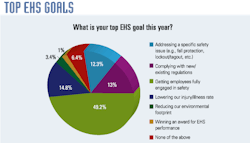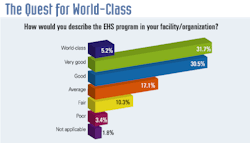Thirty-two teams, four regions, five weeks and 4,086 safety issues found and fixed. By the numbers, that's how the 2014 NCAA Men's Basketball Tournament stacked up for Kimberly Burgess.
As the environmental, health and safety manager for Ingersoll Rand's Trane manufacturing plant in Lynn Haven, Fla., Burgess always is on the lookout for creative ways to engage the plant's 850 employees in workplace safety. So when March Madness rolled around this year, she saw it as a golden opportunity.
"My husband was filling out his brackets, and I got to thinking about the whole March Madness thing, 'Wouldn't it be cool if you could do something like that to get everyone engaged, but give it a safety theme?'" Burgess recalls.
And with that light-bulb moment, "EHS Madness" was born. Burgess divided the plant's workforce into four regions – just like the NCAA tourney – with eight teams per region. The object of the game: Find and fix the most safety issues. At stake: Free lunch for the winning team, T-shirts and – perhaps most importantly – bragging rights.
Burgess sold the idea to team leaders and posted brackets for everyone to see. Even as the field whittled itself down, she kept everyone engaged with the promise of restaurant gift cards for every team in the region that produced the champion. And when the competition hit a fever pitch, Burgess had "stacks and stacks" of documented safety corrections piled on her desk.
"I killed a few trees with it, but it was worth it," Burgess says. "Everybody had fun and we fixed a lot of little issues on the floor, so it was really cool."
Burgess is on the front lines of a never-ending battle being waged by many EHS professionals. In EHS Today's 2014 National Safety Survey, nearly 50 percent of respondents pointed to employee engagement as their No. 1 goal this year. In a separate survey on EHSToday.com, 65 percent of respondents said they have the same goal.
Both surveys – each of which received nearly 900 responses – point to the ongoing challenge of winning the hearts and minds of workers and supervisors, with the end goal of a world-class, self-sustaining safety culture. But the plant-level workforce is just part of the puzzle for EHS professionals, who depend on – and often must solicit – senior-management support of safety.
Fortunately, a healthy majority of our readers indicate that senior leaders are stepping up. Nearly 80 percent of respondents to the 2014 National Safety Survey indicate that their executives provide active and visible support for occupational safety and health. A smaller majority of EHS professionals (64 percent) say they work in organizations that prioritize safety over production.
That's been the case for Burgess at the Trane Lynn Haven facility, which makes commercial and residential HVAC units.
Senior leaders are receptive to her budget requests for safety initiatives, as they realize that "when we invest in something like that, [the investment is] easily recouped."
"Our leadership team doesn't even blink at spending money on safety, recognition and engagement," Burgess says.
Perhaps they're being hard on themselves – or just modest – but a mere 5 percent of survey respondents characterize their EHS programs as "world-class." Encouragingly, though, more than 60 percent of respondents describe their EHS programs as either "very good" or "good," and only 3.4 percent give their programs a "poor" grade.
"Safety can get really boring and dry. If all you're doing is being the safety cop, people aren't going to respond," Burgess says. "If you're out there helping people and engaging them, and you're asking for their ideas and running with them and getting them [implemented], then they see that things are changing for the better, and they're more apt to help you figure out how to make their jobs better, easier and safer."




